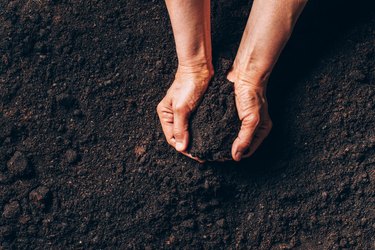
Things You'll Need
Spade or sod cutter
Large tarp or wheelbarrow
Shovel
Compost
Loose and fluffy soil is one of the keys to giving plants a healthy start. Because this kind of soil provides plenty of room for roots to grow, nutrients are readily available and moisture can be held for the plant rather than draining away. While a tiller can produce fine soil in very little time, dirt clods can be broken up by using a standard shovel and a gardening method known as double digging. Through double digging you'll have an opportunity to break up soil clumps while adding nutrients to the garden.
Step 1: Remove Grass Clumps and Upper Inches of Soil
Spray the ground along the outline of the garden area if this spot will be dug for the first time. Remove the top layer of grass and the upper 1 to 2 inches of soil that contain the roots of the grass. Use a spade on small areas and a sod cutter for larger areas.
Video of the Day
Step 2: Choose a Tarp or a Wheelbarrow
Spread a large tarp beside the garden area or bring in a wheelbarrow.
Step 3: Dig a Trench and Remove Debris
Dig a 10- to 12-inch-wide trench down one side of the garden bed with a shovel. As you loosen the soil, lift and dump it onto the tarp or into the wheelbarrow. Pull out rocks and roots as they are uncovered. This will form the first dug row of the garden bed.
Step 4: Dig the Second Trench
Dig a second row or trench of the same width directly beside the first and dump the loosened soil from the second row into the trench of the first. After you place each shovelful of soil into row one, stab at it with the blade of the shovel to break apart large clumps.
Step 5: Dig One Row at a Time
Continue to dig one row at a time and dumping the loose soil into the trench before it, picking out rocks and debris as you go, until you have dug the last possible row on the opposite side of the garden.
Step 6: Dump the Soil, Break Up the Clumps
Drag the tarp or move the wheelbarrow so it is next to the last dug trench. Dump the leftover soil into the last trench, breaking up clumps with the shovel head as you go.
Step 7: Cover the Bed With Compost
Spread 2 to 4 inches of compost over the entire bed area, being careful to stay off of the bed as much as possible.
Step 8: Shovel, Break and Turn
Repeat Steps 2 through 6, working in columns perpendicular to the rows you just finished. With each shovel, break up soil clumps that remain by chopping them with the shovel. Turn the soil as you work to mix the compost layer in with the soil to lighten it.
Tip
Avoid walking on the dug area of ground to make future digging less labor intensive. For best results, double dig to break up soil clumps in the spring to prepare for planting, and add compost. Double dig again in the fall after removing the spent plants from the garden, and add manure during the same process.
Video of the Day